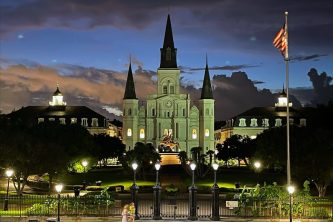Private New Orleans Churches Tour
Tour Details
Our Lady of Guadalupe Church / International Shrine to St. Jude
The church was built in 1826 as the “Chapel of St. Anthony of Padua” (a.k.a. the Mortuary Chapel) to serve as a burial church for victims of yellow fever. It was erected close to St. Louis Cemeteries #1 and #2, the primary Catholic cemeteries at the time (St. Louis Cemetery #1 is located directly behind the church, right across Basin Street). The church building is the oldest surviving church building in New Orleans (all the older churches have since been rebuilt). Since 1918, the church has been named Our Lady of Guadalupe Chapel and has been staffed by the Missionary Oblates of Mary Immaculate. In the 1930s, parishioners praying to Saint Jude had their prayers answered, which resulted in a tradition of regular novenas to Saint Jude (that continues today) and the erection of a shrine to Saint Jude (which is still maintained today). The church has hosted a series of “jazz” Masses. The statue of Saint Expedite is also visited by Catholics, as well as some local followers of Voodoo. The church grounds also feature a Marian grotto, located between the church and the adjacent rectory.
St. Roch Cemetery & Burial Chapel
Writer Lyle Saxon calls St. Roch Cemetery “one of the most unusual cemeteries in New Orleans,” writing that it had an appearance of great age, despite its relative youth. The story of St. Roch Cemetery begins with Holy Trinity Church in the Faubourg Marigny. This lovely church sits defunct and abandoned in a tract of land that was once called “Little Saxony,” since it received the waves of German immigrants pouring into New Orleans during the 1840’s. This German speaking Catholic parish was founded in 1847, while two blocks away is the city’s first Protestant German church, St. Paul Lutheran, founded in 1840. The congregations included artisans, shopkeepers, farmers, dairymen, and the settlers of Milneburg. Holy Trinity served the area as the parish church until 1871, when it was divided and St. Boniface parish was created. The St. Roch cemetery chapel is particularly noteworthy due to the offerings left to those in recognition of answered prayers. The cemetery is well maintained by the current congregation, and is actively used today.
St. Joseph Church
St. Joseph Parish was established in February, 1844 to serve a growing population in the area. The interior measures 100′ x 200′ and 95′ from floor to ceiling, with a seating capacity of 1800 to 2000 people. The main aisle is 12′ x 150′ long, the longest in New Orleans. The exterior of the building measures 100′ x 225′, and is 150′ from ground to roof. Medallions over the front exterior entrance represent Pope Pius IX and Archbishop Napoleon Perche (1805-1883).The first pastors were diocesan priests, Edward D’Hauw and B. M. Poyet. Archbishop Francis Janssens (1888-1897) renovated the “old” church and in 1895 it was placed under the patronage of St. Katherine. More than 150 years ago, St Joseph Church was entrusted to Saint Vincent de Paul and the Missioners of the Congregation of the Mission (Vincentians).
St. Alphonsus Church
St. Alphonsus Church (French: Église Saint-Alphonse) is a historic former church building at 2029 Constance Street in New Orleans, Louisiana. Completed in 1857, it is one of the few surviving national examples of a richly multicolored church interior predating the 1870s, and a high quality example of ecclesiastical Italianate architecture, It has a complex and richly-decorated symmetrical facade, with a central entrance area flanked by two square towers topped by crosses. The facade is ornamented with pilasters, corbelled brick panels, and niches in which statues are mounted. The interior is also richly ornamented, and has a coved plaster ceiling which have been painted with artwork by Dominique Canova. Its stained glass windows are Bavarian in origin, coming from F.X. Zettler. The floors are covered in mosaic tile. It was declared a National Historic Landmark in 1996 for its architectural significance.[2][3] It is now home to the St. Alphonsus Art and Cultural Center.
St. Mary’s Assumption Church / Father Seelos Shrine
St. Mary’s Assumption is home to a shrine and museum for Blessed Francis Xavier Seelos, a German priest who came to the United States to minister to German-speaking immigrants. Fr. Seelos died while serving as the pastor at St. Mary’s Assumption: after visiting and caring for the victims of yellow fever, he succumbed to the disease himself in 1867. In recognition of his virtuous life, Fr. Seelos was beatified by the Roman Catholic Church in 2000. It was declared a National Historic Landmark in 1974, significant as a rare and elaborate example German Baroque Revival architecture. St. Mary’s Assumption is home to a shrine and museum for Blessed Francis Xavier Seelos, a German priest who came to the United States to minister to German-speaking immigrants. Fr. Seelos died while serving as the pastor at St. Mary’s Assumption: after visiting and caring for the victims of yellow fever, he succumbed to the disease himself in 1867. In recognition of his virtuous life, Fr. Seelos was beatified by the Roman Catholic Church in 2000. It was declared a National Historic Landmark in 1974, significant as a rare and elaborate example German Baroque Revival architecture.
Optional visit to:
Saint Mary’s Catholic Church (named by Archbishop Shulte in March of 1994) was built in 1845 as the Chapel of the Archbishops during the administration of Bishop Antoine Blanc. The ground on which the chapel was constructed originally was the site of the Ursuline Convent and chapel dating to the arrival of the Ursulines in New Orleans. After the Ursulines moved down river in 1824, the site became the residence of the Archbishop of New Orleans. The church has born several names through its existence. It was originally called Stainte Marie de l’Archeveche and later Holy Trinity. Later, it became St. Mary’s Italian Church, the official Italian parish of the Archdiocese, with services in the Italian language for the many Sicilian and Italian immigrants who settled in the lower French Quarter. In 1976, the name was changed to Our Lady of Victory to commemorate the Ursulines and their role in the winning of the Battle of New Orleans. Overall, the church has served the French, Spanish, Creole, Irish, German, Slovenian and Italian people as well as native Indians and the Sisters of the Holy Family who are predominantly an African-American order. The original Pilcher organ, built in 1890 for the Ursulines by the Pilcher Bros. of New Orleans, now stands restored and functional in the church choir loft. The church has now been named St. Mary’s Church and it is part of the Antoine Blanc Memorial and Archdiocesan Archives housed at the Vieux Carre location.
The Ursulines Convent
The Ursulines or Sisters of Ursula were the first of many orders of religious women who came to New Orleans and founded schools, orphanages, and asylums and ministered to the needs of the poor. The sisters arrived in the mudhole that was New Orleans in 1727 after a journey that nearly saw them lost at sea or to pirates or disease. Once in town, the Ursulines provided the first decent medical care (saving countless lives) and later founded the local first school and orphanage for girls. They also helped raise girls shipped over from France as marriage material for local men, teaching the girls everything from languages to homemaking of the most exacting sort; laying the foundation for countless local families in the process. The convent dates from 1752 and is the only remaining building from the French colonial period in the United States. It was a rare survival of the disastrous 18th-century fires that destroyed the rest of the French Quarter.
Used by the Ursulines for 90 years, the convent now functions as an archive for the Archdiocese of New Orleans, with documents dating back to 1718.


